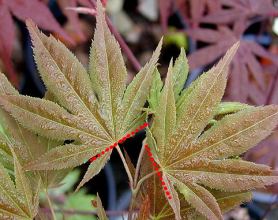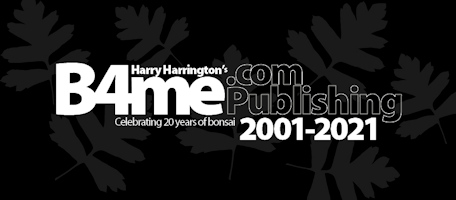|
|
Page 2 of 2:
Partial Defoliation
 Partially
defoliating a bonsai is much kinder and with some tree species
is preferred to total defoliation. Large leaves (or the largest
leaves) are gradually removed through the growing season until
late Summer, these large leaves are slowly replaced by smaller
leaves as and when required.
Partially
defoliating a bonsai is much kinder and with some tree species
is preferred to total defoliation. Large leaves (or the largest
leaves) are gradually removed through the growing season until
late Summer, these large leaves are slowly replaced by smaller
leaves as and when required.
There are several advantages to partial defoliation; the stress
of leaf removal is spread over a number of weeks or months. The
largest leaves tend to be in the strongest, most apical areas
of the tree (that is, the tips of the branches, particularly in
the crown or apex) and their removal enables light to reach the
weak, inner and lower branching. In this way, partial defoliation
can be used as a means to reinvigorating the weaker, lower areas
of a tree by weakening the apical areas.
Species suitable for defoliation techniques
This list by no means complete; other species can be defoliated but I would strongly suggest that unless a particular tree species is recommended for total defoliation by an experienced enthusiast, first try a limit amount of partial defoliation on a specimen to gauge its reaction to defoliation techniques.
Defoliation is normally carried out around midsummer in the UK; however some species are best defoliated a little earlier in late May, the others in mid June. Please note that different climates and differences in the length of growing seasons will alter the optimal time to defoliate according to where you live.
Species to be defoliated in May
Crataegus
species Hawthorns:
Total defoliation in May but partial defoliation of larger leaves
is normally adequate.
Fagus sylvatica
European Beech:
Partially defoliate larger leaves from May. Complete defoliation
has varying degrees of success and is not recommended. For further
details please see Advanced
Pruning Techniques for Beech/Fagus
Quercus robur
European/English Oak:
Partial defoliation of all large leaves from May onwards except
those on weak (often low) branches. Thin out leaves (leaving one
or two on each branches) in heavily congested areas of the tree,
often at the tips of branches.
Sageretia theezans: Total defoliation can be carried out before June and with very vigorous trees, a second time after midsummer.
Ligustrum sp./Privets: Total defoliation can be carried out before June and with very vigorous trees, a second time after midsummer.
Ulmus various
species Field Elms:
Total defoliation in May; also helps combat thickening of the
tertiary twigs that cane be a problem with Field Elms; particularly
for mame and shohin sized trees.
Ulmus parvifolia
Chinese Elm:
Total defoliation in early May can be followed by a second total
defoliation after midsummer if tree is vigorous enough. With only
a small leaf-stalk and huge numbers of leaves even on mame sized
bonsai;rather than cutting with scissors, remove leaves with fingers,
pulling away in the direction of the branch to avoid damaging
the new bud or branches.
Species to be defoliated in June
Acer palmatum
Japanese Maple:
Total defoliation in June is excellent for increasing ramification
and reducing leafsize. Partial defoliation of large leaves recommended
for the weaker red-leaved Acers.
Acer buergerianum
Trident Maple:
Total defoliation can be carried out twice a year on vigorous
specimens.
Carpinus Hornbeams
Total defoliation of only the most vigorous specimens. Otherwise
partial defoliation as per Fagus/Beech species.
Fuchsia species
Fuchsia
Total defoliation can be carried out twice a year in vigorous
specimens
Malus Crab
Apples:
Total or partial defoliation.
Zelkova serrata
Zelkova
Partial defoliation of all but the weakest branches can be carried
out.


